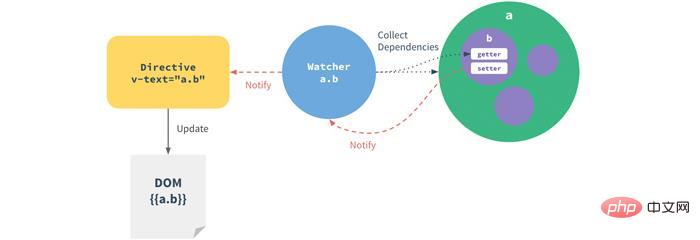 Web Front-end
Web Front-end
 Vue.js
Vue.js
 An article to understand the two-way binding principle of watcher data in Vue (with code)
An article to understand the two-way binding principle of watcher data in Vue (with code)
An article to understand the two-way binding principle of watcher data in Vue (with code)
In the previous article "Analysis of the two-way binding principle of observer data in vue (code sharing)", we learned about the two-way binding principle of observer data in vue. The following article will give you an understanding of the two-way binding principle of watcher data in Vue. It has certain reference value. Friends in need can refer to it.

##vue Data two-way binding principle and simple implementation, this article will implement of mvvm watcher

vue data two-way binding principle-observer
2)vue data two-way binding Defined principle-wather
3)vue data two-way binding principle-parser Complie
vuedata two-way binding principle, And simple implementation, this article will implement mvvmWatcher
watcher.Watcher The subscriber serves as the communication bridge between Observer and Compile , the main things it does are:
dep) when instantiating itself
update()Method
dep.notice(), you can call your own update() method and trigger it The callback bound in Compile releases itself.
// Watcher
function Watcher(vm, exp, cb) {
this.cb = cb;
this.$vm = vm;
this.exp = exp;
// 此处为了触发属性的getter,从而在dep添加自己,结合Observer更易理解
this.value = this.get(); // 将自己添加到订阅器的操作
}
Watcher.prototype = {
update: function () {
this.run(); // 属性值变化收到通知
},
run: function () {
var value = this.get(); // 取到最新值
var oldVal = this.value;
if (value !== oldVal) {
this.value = value;
this.cb.call(this.$vm, value, oldVal); // 执行Compile中绑定的回调,更新视图
}
},
get: function () {
Dep.target = this; // 将当前订阅者指向自己, 缓存
var value = this.$vm[this.exp]; // 强制触发监听的getter,添加自己到属性订阅器中
Dep.target = null; // 添加完毕,重置释放
return value;
},
};function defineReactive(data, key, val) {
var dep = new Dep()
observe(val); // 监听子属性
Object.defineProperty(data, key, {
....
get: function() {
// 由于需要在闭包内添加watcher,所以可以在Dep定义一个全局target属性,暂存watcher, 添加完移除
Dep.target && dep.addDep(Dep.target);
return val;
},
....
});
}Watcher, call the get() method, and pass Dep.target=watcherInstance Mark the subscriber as the current watcher instance and forcefully trigger the getter method defined by the property. When the getter method is executed, it will be in the property's subscriber depAdd the current watcher instance so that watcherInstance can receive update notifications when the property value changes.
MVVM
Here, first connect the listener Observer and the listener Watcher, and simulate some data first , implement simple data binding
<div id="name"></div>
<script>
function Vue(data, el, exp) {
this.data = data;
observe(data);
el.innerHTML = this.data[exp]; // 初始化模板数据的值
new Watcher(this, exp, function (value) {
el.innerHTML = value;
});
return this;
}
var ele = document.querySelector("#name");
var vue = new Vue(
{
name: "hello world",
},
ele,
"name"
);
setInterval(function () {
vue.data.name = "chuchur " + new Date() * 1;
}, 1000);
</script>div is initially hello world, and changes to chuchur after every second Adding timestamp, although it is implemented, is still far from what was imagined. It is vue.name not vue.data.name, so here you need to add a property proxy method to the Vue instance to access vm## The attribute proxy of # is to access the attributes of vm.data. The modified code is as follows: <div class="code" style="position:relative; padding:0px; margin:0px;"><pre class='brush:php;toolbar:false;'>function Vue(options) {
this.$options = options || {};
this.data = this.$options.data;
// 属性代理,实现 vm.xxx -> vm.data.xxx
var self = this;
Object.keys(this.data).forEach(function(key) {
self.proxy(key); // 绑定代理属性
});
observe(this.data, this);
el.innerHTML = this.data[exp]; // 初始化模板数据的值
new Watcher(this, exp, function(value) {
el.innerHTML = value;
});
return this;
}
Vue.prototype = {
proxy: function(key) {
var self = this;
Object.defineProperty(this, key, {
enumerable: false,
configurable: true,
get: function proxyGetter() {
return self.data[key];
},
set: function proxySetter(newVal) {
self.data[key] = newVal;
}
});
}
}</pre><div class="contentsignin">Copy after login</div></div> Then you can directly modify the template data through </p>vue.name<p> , the next step is to implement the parser <code>Complie [End]
Recommended learning:
vue.js tutorialThe above is the detailed content of An article to understand the two-way binding principle of watcher data in Vue (with code). For more information, please follow other related articles on the PHP Chinese website!

Hot AI Tools

Undresser.AI Undress
AI-powered app for creating realistic nude photos

AI Clothes Remover
Online AI tool for removing clothes from photos.

Undress AI Tool
Undress images for free

Clothoff.io
AI clothes remover

Video Face Swap
Swap faces in any video effortlessly with our completely free AI face swap tool!

Hot Article

Hot Tools

Notepad++7.3.1
Easy-to-use and free code editor

SublimeText3 Chinese version
Chinese version, very easy to use

Zend Studio 13.0.1
Powerful PHP integrated development environment

Dreamweaver CS6
Visual web development tools

SublimeText3 Mac version
God-level code editing software (SublimeText3)

Hot Topics
 1386
1386
 52
52
 How to use bootstrap in vue
Apr 07, 2025 pm 11:33 PM
How to use bootstrap in vue
Apr 07, 2025 pm 11:33 PM
Using Bootstrap in Vue.js is divided into five steps: Install Bootstrap. Import Bootstrap in main.js. Use the Bootstrap component directly in the template. Optional: Custom style. Optional: Use plug-ins.
 How to add functions to buttons for vue
Apr 08, 2025 am 08:51 AM
How to add functions to buttons for vue
Apr 08, 2025 am 08:51 AM
You can add a function to the Vue button by binding the button in the HTML template to a method. Define the method and write function logic in the Vue instance.
 How to reference js file with vue.js
Apr 07, 2025 pm 11:27 PM
How to reference js file with vue.js
Apr 07, 2025 pm 11:27 PM
There are three ways to refer to JS files in Vue.js: directly specify the path using the <script> tag;; dynamic import using the mounted() lifecycle hook; and importing through the Vuex state management library.
 How to use watch in vue
Apr 07, 2025 pm 11:36 PM
How to use watch in vue
Apr 07, 2025 pm 11:36 PM
The watch option in Vue.js allows developers to listen for changes in specific data. When the data changes, watch triggers a callback function to perform update views or other tasks. Its configuration options include immediate, which specifies whether to execute a callback immediately, and deep, which specifies whether to recursively listen to changes to objects or arrays.
 What does vue multi-page development mean?
Apr 07, 2025 pm 11:57 PM
What does vue multi-page development mean?
Apr 07, 2025 pm 11:57 PM
Vue multi-page development is a way to build applications using the Vue.js framework, where the application is divided into separate pages: Code Maintenance: Splitting the application into multiple pages can make the code easier to manage and maintain. Modularity: Each page can be used as a separate module for easy reuse and replacement. Simple routing: Navigation between pages can be managed through simple routing configuration. SEO Optimization: Each page has its own URL, which helps SEO.
 How to return to previous page by vue
Apr 07, 2025 pm 11:30 PM
How to return to previous page by vue
Apr 07, 2025 pm 11:30 PM
Vue.js has four methods to return to the previous page: $router.go(-1)$router.back() uses <router-link to="/" component window.history.back(), and the method selection depends on the scene.
 How to query the version of vue
Apr 07, 2025 pm 11:24 PM
How to query the version of vue
Apr 07, 2025 pm 11:24 PM
You can query the Vue version by using Vue Devtools to view the Vue tab in the browser's console. Use npm to run the "npm list -g vue" command. Find the Vue item in the "dependencies" object of the package.json file. For Vue CLI projects, run the "vue --version" command. Check the version information in the <script> tag in the HTML file that refers to the Vue file.
 How to use function intercept vue
Apr 08, 2025 am 06:51 AM
How to use function intercept vue
Apr 08, 2025 am 06:51 AM
Function interception in Vue is a technique used to limit the number of times a function is called within a specified time period and prevent performance problems. The implementation method is: import the lodash library: import { debounce } from 'lodash'; Use the debounce function to create an intercept function: const debouncedFunction = debounce(() => { / Logical / }, 500); Call the intercept function, and the control function is called at most once in 500 milliseconds.



